
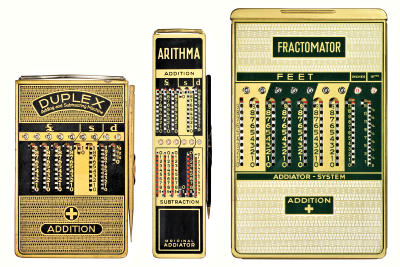
The slide adding machine is a simple mechanical device for addition and subtraction. "Addiator" was the brand name of the major German manufacturer, but is often used as a generic term for devices of similar construction.
Slide adders were very popular from the 1850s until the early 1970s. They were made of wood, metal, or plastic in a variety of sizes and configurations. Small machines were sold in great numbers as the "pocket calculators" of the day. Larger models were often packaged in elegant wallets or pocket-book cases, or mounted in desktop stands for regular office use.
The machines were made for a wide variety of measurement systems, including Sterling and decimal currency, Indian rupees, Imperial weights, hours and minutes, feet and inches, and fractions. There were even octal and hexadecimal models for the computer programmers of the 1960s.
This page describes the construction and basic operation of typical slide adding machines. It gives a brief overview of their history, discusses several common arrangements of slides and scales, and shows a collection of typical machines from Addiator, from related companies, and from other manufacturers.

The slide adder consists of little more than a frame which holds a series of numbered strips or slides. There is no actual "mechanism" - the operator simply moves the strips up and down by hand with the aid of a suitable pen or stylus.
This view shows the internal construction of a typical "double-ended" machine.
At the left is the top cover, usually made of brass, steel, or aluminium. The cover has vertical slots to guide the stylus, and a row of windows across the centre to show the results.
Next is an internal plate with vertical divisions to guide the numeral strips. The strips are colour-coded, and have holes or notches to engage with the stylus. They move easily, but have sufficient friction to stay where they are put.
Clearing the machine is done by a rectangular loop of stiff wire which runs around the inside edge of the guide plate. When the handle is raised, the bottom of the loop collects the sliders and returns them to the uppermost or zero position.
The painted bottom cover has a clip on the right-hand side to hold the operating stylus.
The top and bottom covers generally slide or clip together without needing screws or fasteners.

The illustration shows two columns of a typical Addiator. The calculation starts with the machine cleared to zero, as shown in the left-hand column.
To add (eg) 5, the operator inserts a metal stylus into the hole adjacent to the number and pulls the slide down to the bottom of the slot. The situation then appears as shown in the right-hand column. The number 5 is shown in the result window above, and the upper portion of the slide has turned red.
Numbers appearing in the clear portion of the slide can now be added directly by the same method. The red portion indicates numbers that can not be added directly, as the slide only has 10 positions and will not move down far enough. The addition has to be performed by subtracting the complement of the number and adding ten in the next column to the left.
Although this sounds complicated, it is mechanised by a simple process of inserting the stylus at the required number (eg 7), moving the slide up to the top of the slot (thus subtracting the complement 3), passing "around the bend" to engage with the slide in the next column, and moving back down the short slot to the end (thus adding 1 in the "tens" column). The result (5 - 3 + 10 = 12) will appear in the windows. Note that the openings in the red section are slots rather than holes, to allow the stylus to move to the left.
The situation becomes more complicated when successive carries are required, such as when adding to a number containing a series of nines. The whole operation has to be inverted to perform subtraction by the addition of complements, or (in the red section) by direct addition and "borrowing" of tens.
Several different construction methods and operating rules were devised to reduce the obvious potential for confusion, and to assist the operator in obtaining the correct results. Some of these will be described in the sections following.
The modern history of the slide adder goes back to at least 1849, when Samuel Young of Ohio received US Patent 6602 for a wooden adder that operated horizontally. Young's machine introduced the use of colours on the slides to indicate the direction of movement and the need for a tens-carry to the next column. The carry had to be performed manually by the operator.
In 1869 Henry Kummer of New York obtained US Patent 90,275 for an improved adder based on Young's machine. Kummer arranged the machine vertically and used a "double-ended" construction with separate slots for addition and subtraction (similar to the machine illustrated internally above). He mechanised the carrying process by introducing "carrying angles" or "bends" and allowing the operating pin or stylus to move sideways into the higher column. Many other inventors developed and patented "improvements" to these basic ideas.
The mechanism of the "double-sided" or duplex slide adder was developed by Carl Kübler and Otto Meuter in Germany in about 1918. They received US Patent 1,569,108 in 1921. Kübler (1875-1953) established the "Addiator" company in Berlin and commenced manufacture in 1920. His son and daughter both joined the family company.
In 1924 Otto Meuter's wife Lucie filed a patent application for a novel slide adder with a hinged masking plate to switch between adding and subtracting modes (US Patent 1,661,277). This machine was manufactured in Germany under the name "Correntator". In 1928 Otto Meuter established his own business to manufacture another style of slide adder under the name "Produx".
Production was disrupted during WW2 and many factories were destroyed. After the war, Kübler's daughter Margot set about rebuilding the Addiator business in Berlin. His son Hans-Wolfgang set up in opposition, initially building identical machines under the name "Addimult". Meuter's wife Lucie continued to build the Produx machines in East Germany using the name "Record", while their son Klaus revived the Produx line in the West. The Correntator was re-tooled and manufactured in Switzerland, while an identical machine was made in England as the "Exactus". Many low-cost copies and variants of these machines appeared from sources in Asia and North America.
Production of mechanical slide adders came to an abrupt end in the early 1970s as the "calculator wars" produced four-function electronic machines at throw-away prices.
Of all the different arrangements of slots, scales, and operating
rules, the double-sided or "duplex" design patented by Kübler and
Meuter in 1919 was by far the best. To understand why, it helps to look
first at some of the inferior designs.
 One slot, bends at both ends
One slot, bends at both ends
The simplest (and most confusing) construction has a single set of slots with bends at both ends. The upper bends are used for addition, and the lower for subtraction. The slides on this machine are coloured opposite to the example above (white at the top, red below), but the principle is the same.
Addition proceeds as described, with the slides moving down for numbers in the red section, or "up and around the bend" in the white. The bends on this machine are just widenings of the slots, with no clear separation between the two columns.
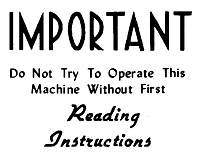 Subtraction involves adding the complement shown in the small
numbers to the left of the main scales. The direction of movement is
still the same (down for red, up for white), but the rule is
different: down and around the bend for red, up but not around
the bend for white.
Subtraction involves adding the complement shown in the small
numbers to the left of the main scales. The direction of movement is
still the same (down for red, up for white), but the rule is
different: down and around the bend for red, up but not around
the bend for white.
This simple mechanical construction was used in several low-cost machines from Asia and North America, including the "Baby Calculator" and the "Magic Brain". The complement scales, two sets of bends, and different rules for addition and subtraction created plenty of opportunity for confusion - as evidenced by this warning notice on the front page of the "Baby" instructions.
 One slot, bends at both ends, with masking plate
One slot, bends at both ends, with masking plate
This design has a similar set of slots with bends at both ends, but reduces the potential for confusion with an ingenious "false front" or masking panel. This invention was patented by Lucie Meuter in 1924.
The masking panel is hinged across the centre of the machine, adjacent to the row of fives, and covers either the upper or lower section of the scales. Flipping the panel up or down switches the machine between adding and subtracting modes by reversing the markings and displaying only the corresponding set of bends.
The left-hand view shows the setting for addition, with the panel covering the lower half of the operating slots. Numerals 9 to 5 are marked on the face of the machine, while 4 to 0 are on the panel. There is only a single set of numbers (without complements), a single set of bends at the tops of the slots, and a much clearer separation between the columns. Addition is the same as previously described, with the slides moving down for clear numbers, or up and around the bend for red.
The right-hand views shows the setting for subtraction, with the masking panel flipped over to cover the upper half of the slots. The bends are now at the bottoms of the slots, with the numerals magically reversed to show only the complements. (0 to 4 are on the masking panel, 5 to 9 are on the body of the machine). The direction of movement is still the same (down for clear numbers, up for red), but "around the bend" is now only possible at the lower ends of the slots.
 Double-ended, separate slots for addition and subtraction
Double-ended, separate slots for addition and subtraction
This "double-ended" scale arrangement from a 1960s Addiator is identical in principle to that described in Henry Kummer's patent from 1869. It differs only in that Kummer numbered the slots in the reverse order, which placed the bends near the centre of the machine. Either way, the double-ended construction clearly separates addition and subtraction by providing separate scales and slots for each.
There is one consistent operating rule for both functions - numbers in the clear sections move towards the centre of the machine, while those in the red sections move outwards and around the bend.
The double-ended construction greatly reduces the potential for confusion, but at the expense of creating a rather long and narrow machine.
 Double-sided (Duplex) construction
Double-sided (Duplex) construction
Kübler and Meuter's "Duplex" Addiator separates addition and subtraction even further by placing addition on the front and subtraction on the back of a double-sided machine.
The left-hand illustration shows the front or Addition side. The slots are well separated, are clearly and simply marked, and have obvious bends at the top. The slides are red at the top and clear below.
When the machine is turned over (top to bottom), the operator sees an identical layout on the subtraction side. The slides are still red at the top and clear below, the bends are still at the tops of the slots, the numbers still run in the same direction, and the operating rule is still the same - down for clear numbers, up and around the bend for red.
The double-sided machine eliminates all potential for confusion and error by providing a consistent "user interface" with a single operating rule, but at the expense of a slightly more complicated mechanical construction.
The Addiator company operated in Berlin from 1920 until the early 1970s. Their machines were made in five standard sizes, although the largest and smallest sizes are rarely found. The three more common models are the large double-sided "Standard", the pocket-sized "Duplex", and the narrow double-ended "Arithma". This section shows a typical selection of each. (Click on the photos to enlarge).
 Addiator "Standard", s/n 600110
Addiator "Standard", s/n 600110
9 columns, decimal
Dimensions: 109W x 172D x 7H
Weight: 240g
The Addiator "Standard" is a substantial machine made from etched and coloured brass and mounted in an elegant "notebook" or "pocket-book" case. The "book" measures 125 x 185 x 25mm overall and weighs around 430g.
The machine slides into a hinged bracket attached to the front cover of the book, and can be folded forward to access the subtraction side. The padded case includes an instruction sheet, a replaceable notepad, and a combined operating stylus and propelling pencil.
Addiator Standard 600110 in green notebook case.
 Addiator "Standard", s/n 239550
Addiator "Standard", s/n 239550
9 columns, Sterling currency
Dimensions: 109W x 172D x 7H
Weight: 240g
The Addiator company used several different geometric patterns in the etching on the faces of the machines, and many different arrangements in the design, colour, and placement of the lettering. (The red sticker is not from Addiator, but from the Australian distributor Able Staples).
This Sterling-currency Standard was supplied prior to Australia's decimal currency conversion in 1966.
Standard 239550 in green notebook case.
Standard 239550 with original box.
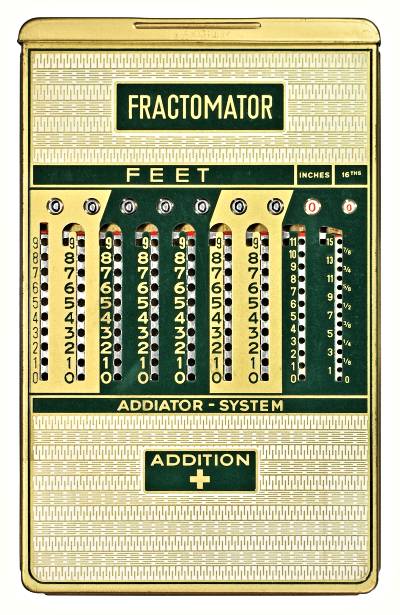 Addiator "Fractomator", s/n 403424
Addiator "Fractomator", s/n 403424
9 columns for Feet, Inches and Sixteenths
Dimensions: 109W x 172D x 7H
Weight: 240g
The "Fractomator" is an Addiator Standard adapted for calculation of lengths in the Imperial system. The machine is calibrated in Feet (decimal), Inches (base 12), and Sixteenths, and is intended for use by those in the timber and building trades. The colour coding is arranged so that the seven decimal columns can also be used for currency calculations.
The Fractomator was a high-class instrument and was usually supplied in a genuine leather notebook case. Even the notepad had leather trimmings.
Fractomator 403424 in leather case.
Fractomator 403424 in leather case showing Subtraction side.
 Addiator "Fractomator Negative", s/n 400857
Addiator "Fractomator Negative", s/n 400857
9 columns for Feet, Inches and Sixteenths
Dimensions: 109W x 172D x 7H
Weight: 240g
The subtraction side of this "Fractomator Negative" has an extra set of square windows which show the complement of the number in the circular result windows. The square windows are used in the case of subtraction below zero to show the true value of a negative balance.
Carl Kübler developed the "Negative Balance" windows in 1930 and received US Patent 1,961,053 in 1934. The feature was available as an option on many other models.
Fractomator Negative 400857 in green case.
 Addiator "Quantotar", s/n G700009
Addiator "Quantotar", s/n G700009
9 columns for Imperial weights
Dimensions: 109W x 172D x 7H
Weight: 250g
The "Quantotar" is an Addiator Standard adapted for calculation of weights in the Imperial system. The machine is calibrated in tons (decimal), hundredweight (Cwt, base 20), quarters (Qus, base 4), pounds (Lbs, base 28), and ounces (Ozs, base 16). Tons, hundredweight, and quarters were used for bulk and bagged goods (cement, stock feed, etc, with 20 hundredweight bags to the ton), while pounds and ounces were in general and domestic use. (A "stone" of 14 pounds was also used, mainly to express the weight of people, but does not appear on the Quantotar).
This Quantotar has an unusual and initially confusing pocket-book case. Rather than being attached to the front cover, the machine is held in a sleeve which is hinged in the normal manner between the front and back covers of the book. To maintain Addiator's practice of having the machine always on the left, it is necessary to open the book from the back to access the addition side. To change to subtraction, the book must be closed (left to right), turned top-to-bottom, and re-opened from the back. The entire book is inverted, not just the machine.
Quantotar G700009 in black book-style case.
 Addiator "Duplex", s/n 171705
Addiator "Duplex", s/n 171705
8/9 columns, Sterling currency
Dimensions: 79W x 124D x 5H
Weight: 156g
The Addiator Duplex is a "pocket-sized" machine about 25% smaller than the original Standard model. It retains the 9 result windows of the larger model, but only has 8 input columns. It was supplied in a basic leather slip case, or in a more elaborate fabric-lined leather case with a zip fastener. A decorated clip was provided to hold the fancy brass stylus. These Sterling-currency machines were very popular in Australia before the change to decimal in 1966.
Another Duplex with original box and leather slip case.
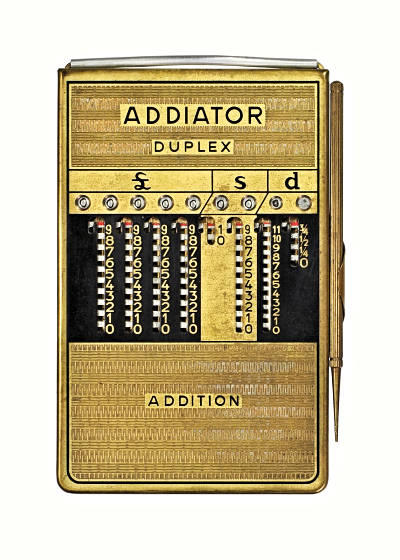 Addiator "Duplex"
Addiator "Duplex"
8/9 columns, Sterling currency
Dimensions: 79W x 124D x 5H
Weight: 135g
Another version of the Addiator Duplex for Sterling currency, with instruction leaflet and an embossed leather slip case. The original owner purchased this unit at the International Fair at the Melbourne Exhibition Buildings in March 1959.
 Addiator "Arithma"
Addiator "Arithma"
6 columns for Sterling or decimal currency
Dimensions: 38W x 156D x 4H
Weight: Brass 60g, aluminium 40g
The Addiator "Arithma" is a single-sided "pocket calculator" using the double-ended scale arrangement.
The Sterling-currency unit on the left is of brass construction, with a plain metal stylus and an embossed leather slip case.
The later decimal-currency unit on the right is made from anodised aluminium, and is much less substantial than the brass unit.
Arithma Sterling with original box, slip case, and instruction sheet.
 Addiator "Addfeet Junior"
Addiator "Addfeet Junior"
6 columns for feet, inches, and eighths
Dimensions: 38W x 156D x 4H
Weight: 52g
The "Addfeet Junior" is an Arithma-sized version of the Fractomator (above) for calculation of Imperial lengths. There are four decimal columns for feet, one for inches (base 12), and one for eighths.
Addfeet Junior with leather slip case.
 Addiator Slide Rule, Faber-Castell 67/22 Rb "Business"
Addiator Slide Rule, Faber-Castell 67/22 Rb "Business"
6 columns, decimal
Dimensions: 42W x 160D x 8H
Weight: 55g, 85g with case
Manufactured: Germany, 1966
The "Addiator Slide Rule" is a conventional 6- or 10-inch slide rule from Faber-Castell with an Arithma-sized Addiator mounted permanently on the back. The slide rule performs multiplication and division, while the Addiator does addition and subtraction. There is no connection between the two sides.
In the unit illustrated the Arithma occupies the whole of the rear side of a standard 6-inch "Business" slide rule (67/22Rb). The upper and lower ends of the Addiator carry small diagrams showing methods of calculating on the slide rule. This unit was supplied in a semi-rigid case with a zip fastener. The slide rule is dated 1966 in Faber-Castell's normal manner.
This Arithma has an extra set of square windows (below the subtraction scales) which show the complement of the number in the circular result windows. The square windows are used in the case of subtraction below zero to show the true value of a negative balance.
 Addiator Slide Rule, Faber-Castell 67/87 Rb "Rietz"
Addiator Slide Rule, Faber-Castell 67/87 Rb "Rietz"
6 columns, decimal
Dimensions: 42W x 160D x 8H
Weight: 55g, 85g with case
Manufactured: Germany, 1962
Carl Kübler developed the combination of Addiator and slide rule in 1936 and received US Patent 2,153,089 in 1939. About 20 different models were produced in several of Faber-Castell's standard scale arrangements. This model uses the engineer's "System Rietz" scales (67/87 Rb). The ends of the Addiator are printed with small tables of decimal equivalents.
Addiators and even Addiator slide rules were often used by major businesses as promotional materials and as gifts for valued customers. This unit was prepared in 1962 for Rocla Pipes Pty. Ltd., a major Australian manufacturer of concrete pipes and construction products. 1962 was Rocla's 40th anniversary, and they are still very much in business.
 Addiator "Hexadat", s/n 692917
Addiator "Hexadat", s/n 692917
8 columns, hexadecimal (base 16)
Dimensions: 61W x 228D x 4H
Weight: 137g
The Hexadat was introduced in 1967 to assist computer programmers with calculation of addresses and offsets in the hexadecimal (base 16) numbering system. It is an 8-column double-ended machine in Addiator's traditional brass construction. The length of 228mm was the longest of the five Addiator models.
The hexadecimal system is used as a "shorthand" for representing binary numbers. Computers work internally in the binary system, but programmers handle long binary numbers by dividing them into groups of 3 or 4 bits at a time. 3 bits can represent numbers from 0 to 7 (the base-8 or octal system), while 4 bits can represent 0 to 15 (base-16 or hexadecimal). We have no single numeric characters for the numbers 10 to 15, so the hexadecimal system borrows the letters A to F.
For example, when the 16-bit binary number 1010011100101110 is divided into groups of 3 (from the right) it becomes 1 010 011 100 101 110. When each group is translated into its octal value it is written as 123456. If divided into groups of 4 it becomes 1010 0111 0010 1110. When each group is translated into its hexadecimal value it is written as A72E - far more convenient than 1010011100101110. The difficulty comes when the programmer needs to add or subtract A72E and (eg) 7F94. Mental arithmetic in hexadecimal becomes easier with practice, but is much easier with the Hexadat.
Addiator also made an Arithma-sized "Octadat" for the octal system. It was not until 1982 that Hewlett-Packard produced the HP-16C "Programmer's calculator" which worked equally well in decimal, hexadecimal, octal and binary formats.
The Addiator company was established by Carl Kübler and Otto Meuter in 1920. By the 1950s the members of these two families were involved in six competing brands. This section shows a range of these Addiator family relatives.
 Produx slide adder, model ST
Produx slide adder, model ST
Double-ended slide adder, 7/8 columns, decimal
Dimensions: 55W x 115D x 3H
Weight (in case): 60g
Manufactured: Foreign
Otto Meuter left Addiator soon after the company became established and manufactured his own "Produx" slide adders from 1928.
This Produx ST is a very small machine of brass construction, about the same width as a modern credit card and only slightly longer. It is glued into a light folding cover with a loop to hold the operating stylus. It differs from the double-ended Addiators by placing the Addition section at the bottom, which puts the bends near the result windows in the centre. The usual double-ended length is reduced by not enclosing an empty space for the lower ends of the slides and just letting them extend below the machine when in use. This also removes the need for a clearing mechanism, as the slides are simply pushed back by hand.
 Produx slide adder, model M
Produx slide adder, model M
Double-ended slide adder, 8/9 columns, decimal
Dimensions: 86W x 155D x 4H
Weight: 83g.
Manufactured: Made in Germany - West.
After the war Meuter's wife Lucie continued to build the Produx machines in East Germany under the name "Record", while a new firm "Otto Meuter and Son" was established at Achim (near Bremen) to build Produx machines in the West.
This Model M is a double-ended machine of aluminium construction with Addition at the lower end. The slides are fully enclosed, and there is a conventional clearing mechanism. The machine was supplied in a clear plastic slip case with operating stylus and instruction sheet.
 Correntator slide adder
Correntator slide adder
8/9 columns, Sterling currency
Dimensions: 70W x 102D x 3H
Weight: 75g
Manufactured: Made in Germany
In 1924 Otto Meuter's wife Lucie filed a patent application for a novel slide adder with a hinged masking plate to switch between adding and subtracting modes (US Patent 1,661,277). The machine was manufactured in two sizes under the name "Correntator".
The illustration shows a pre-war version of the smaller "pocket-sized" Correntator. It is of brass construction, with 8/9 columns for Sterling currency. This machine was supplied in a light wallet-style case with a small graph-paper notepad.
The operation of the masking plate is described in the Scale arrangements section above.
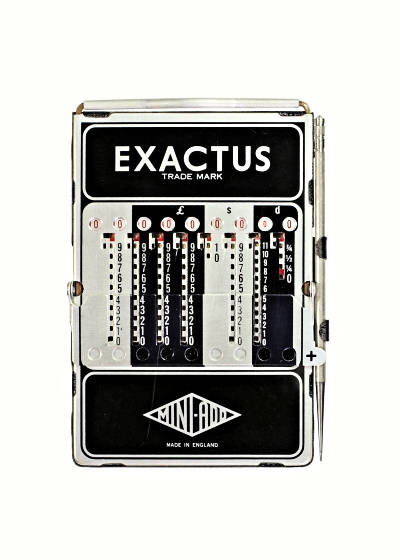 Exactus "Mini-Add"
Exactus "Mini-Add"
8/9 columns, Sterling currency
Dimensions: 70W x 102D x 3H
Weight: 60g
Manufactured: Made in England
After the war the Correntator was re-established in Switzerland as the "Unical Correntator", and identical machines were built in England under the name "Exactus". The only changes were that the new machines were made of aluminium, the clip for the stylus was formed as part of the backplate, and a finger tab was provided to assist in lifting the masking plate.
Two versions of the Exactus Mini-Add packing box.
 Exactus Mini-Add in desk stand
Exactus Mini-Add in desk stand
10 columns, Sterling currency
Dimensions: adder 120W x 160D x 6H, overall 225W x 162D x 128H
Weight: 1.66kg
Manufactured: England
This is a larger version of the Correntator/Exactus above, although it still goes by the name "Mini-Add". The device itself is about 60% larger than the pocket version and has a knob as well as the finger tab to flip the cover plate.
The die-cast desk stand is finished in green hammertone and has a pocket at the top right for a combined operating stylus and propelling pencil. The space inside the stand is empty, apart from a 2-pound chunk of scrap iron fastened inside the base for ballast. It is not known whether this was "original equipment".
 Addimult "Addmaster", S/N 806123
Addimult "Addmaster", S/N 806123
9 columns, Sterling currency
Dimensions: 108W x 172D x 7H
Weight: 240g, 500g with stand.
Manufactured: Foreign
Carl Kübler's son Hans-Wolfgang left the family Addiator business at the end of the war and set up his own "Addimult" company. His first slide adders (from about 1948) were almost identical to the pre-war Addiator, as they were actually made on "rescued" Addiator equipment.
This well-used Addimult "Addmaster" is a 9-column slide adder for Sterling currency, almost identical to the Addiator Standard. It is securely protected in a detachable metal case which unfolds to make a convenient desk stand. The mechanism tilts forward to access the Subtraction side.
Addmaster in metal case.
Addmaster case as desk stand.
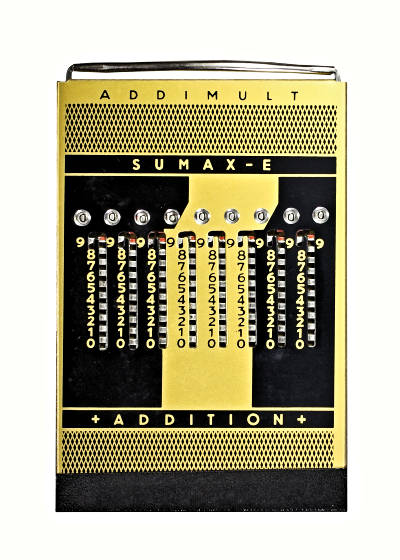 Addimult "SUMAX-E"
Addimult "SUMAX-E"
8/9 columns, decimal currency
Dimensions: 82W x 125D x 5H
Weight (in notebook case): 186g
Manufactured: Made in Western Germany
By the early 1950s Addimult had developed its own distinctive style of double-sided machines in bright anodised aluminium.
This "Sumax-E" is a smaller 9-column machine for decimal currency. The mechanism is permanently hinged into a plastic notebook case with a notepad and a combined stylus and ball-point pen. The machine is attached to the right-hand side of the case, so that the "book" can be opened in the expected manner.
Sumax-E in notebook case.
Sumax-E with original box.
 Addimult "Addmaster Baby"
Addimult "Addmaster Baby"
6 columns, decimal currency
Dimensions: 60W x 123D x 5H
Weight: 68g
Manufactured: Made in Western Germany
The Addmaster Baby is a pocket-size 6-column duplex slide adder for decimal currency with a metal stylus and two-tone plastic slip case.
 "Kingson" Slide Adders
"Kingson" Slide Adders
6 columns, Sterling and decimal
Dimensions: 37W x 156D x 4H
Weight: 40g
Manufactured: Hong Kong, 1950s and 60s
These double-ended "Kingson" slide adders are Hong Kong copies of the Addiator Arithma.
On the left is a Sterling-currency unit from the 1950s. The "fine print" at the bottom says "Empire Made", in acknowledgement of the tarrif concessions existing at that time between the countries of the British Empire.
The decimal version on the right was built specifically for the Australian market during the conversion from Sterling to decimal currency in 1966. The currency conversion table printed on the top face was only relevant in Australia.
Kingson with original box, sleeve, and instructions.
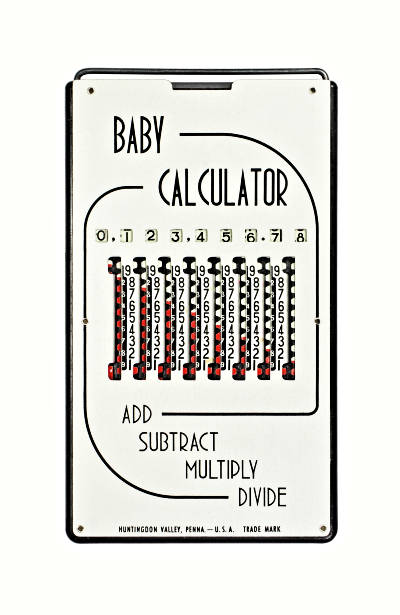 "Baby Calculator"
"Baby Calculator"
8/9 columns, decimal
Dimensions: 82W x 140D x 7H
Weight: 120g
Manufactured: U.S.A.
The "Baby" calculator is a single-sided 8/9-column slide adder for decimal currency. It was supplied with an instruction leaflet, metal stylus, and a red plastic slip case. No maker's name is given, but the faceplate is labelled "Huntingdon Valley, Penna. - USA".
The slots are marked with complements for use in subtraction, and have bends at both ends. The operation is described in the Scale arrangements section above.
 "Magic Brain Calculator"
"Magic Brain Calculator"
7/8 columns, decimal
Dimensions: 75W x 140D x 8H
Weight: 72g
Manufactured: Made in Japan
The Magic Brain is generally similar to the Baby above. It has the same style of construction and the same scale arrangement, but is slightly narrower with one less column. The plastic body is labelled "Made in Japan".
 "Ve-Po-Ad" Slide Adder
"Ve-Po-Ad" Slide Adder
8/9 columns, decimal
Dimensions: 76W x 120D x 4H
Weight (in case): 110g
Manufactured: Chicago, 1920s-30s
The "Ve-Po-Ad" or "Vest Pocket Adder" was made by a division of the Reliable typewriter company of Chicago from 1924 until the 1930s. It is an 8/9 column machine for decimal currency, of brass construction, and permanently mounted in a light folding "wallet" of fabric and cardboard.
The machine is unusual in that it is marked with complements for subtraction, but only has bends for addition at the tops of the slots. The instruction sheet describes how "borrowing" from the next column has to be performed manually.

The history and products of the Addiator company are described in great detail on Friedrich Diestelkamp's web site. The site is mostly in German, but is well illustrated.